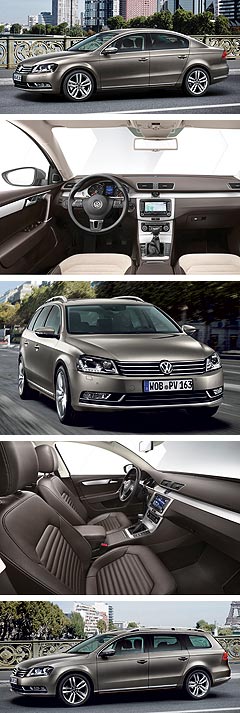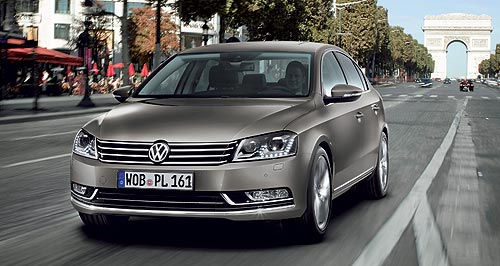Future models - Volkswagen - PassatParis show: VW improves Passat positionSecond skin: Seventh-generation Passat has an upmarket new look and more technology but is built on the current platform. VW’s redesigned Passat offers fresh styling, frugal engines and clever features30 Sep 2010 By TERRY MARTIN VOLKSWAGEN has unveiled its redesigned Passat sedan and wagon at the Paris motor show ahead of an Australian debut in the first half of 2011. The third biggest-selling model for Volkswagen in Australia behind the Golf small car and the Tiguan compact SUV, the medium-sized Passat enters its seventh generation with a comprehensive overhaul inside and out, a host of advanced engines and some clever features, but uses the same basic vehicle architecture as the current model. In Paris, the German manufacturer, which has designs on becoming the world number-one during this decade, claimed the new Passat brings with it benchmarks in “quality, design, economy and comfort” and was “not only the most advanced iteration yet but also the most efficient”. On that score, VW has introduced no fewer than 10 upgraded engines – not all of which will come to Australia but which all achieve fuel consumption reductions of up to 18 per cent. All will be available with either a manual or DSG dual-clutch automatic gearbox. The headline act is a 77kW/250Nm 1.6-litre turbo-diesel engine that in BlueMotion guise – now suitable for Australian conditions – consumes a hybrid-like 4.2L/100km, emits just 109g/km of CO2 and has a theoretical driving range of more than 1600km.  Idle-stop technology and smaller-displacement engines are other noticeable elements of the new Passat powertrain line-up, such as a 90kW 1.4 TSI petrol that returns 5.8L/100km and 148g/km of CO2 – again, when the BlueMotion package of changes, which includes low-rolling-resistance tyres, idle-stop and battery regeneration, is included. Idle-stop technology and smaller-displacement engines are other noticeable elements of the new Passat powertrain line-up, such as a 90kW 1.4 TSI petrol that returns 5.8L/100km and 148g/km of CO2 – again, when the BlueMotion package of changes, which includes low-rolling-resistance tyres, idle-stop and battery regeneration, is included.The petrol engine range also includes a 118kW 1.8-litre TSI unit, a 154kW 2.0-litre TSI and a range-topping 220kW 3.6-litre V6. As well as the 1.6 TDI turbo-diesel unit, the Passat will be available overseas with a 2.0-litre TDI in two power outputs – 103kW and 125kW. From the studio of VW Group design chief Walter de Silva and VW brand design head Klaus Bischoff, the Passat has emerged with the same proportions but “clean surfaces and an elegant yet imposing stance”. The redesign is obvious with its heavily contoured headlights (with LED daytime running lights incorporated), a bold new grille with prominent horizontal chrome fins, further chrome highlights across the flanks and rear end, and reshaped tail-lights. Volkswagen claims all body panels apart from the roof are new. Measuring 4769mm in overall length (wagon: 4771mm), the new Passat is slightly longer than the current model (+4mm) but the 1820mm width and 1474mm height (wagon: 1519mm) are unchanged. Inside, the mood is more upmarket with higher-level features (including front seats with a heating, cooling and massaging function), ‘subtle’ chrome inserts, optional Phaeton-style ambient lighting and new detailing across the dashboard with fresh trim finishes, an analogue clock and revised dials. Other features to filter down from luxury models such as the Touareg and Phaeton touch on safety and comfort technologies, including the City emergency braking function. This is part of the adaptive cruise control system and can automatically engage the brakes at speeds below 30km/h should the vehicle sense an unavoidable collision. It can also accelerate the vehicle automatically if it detects an imminent rear-end shunt (and senses a clear space ahead). The new-generation Passat also comes with the option of a fatigue detection system that monitors the driver’s inputs and can automatically emit an audible and visual warning to recommend the driver pulls over. This is said to be the first of its kind in this class. There is also a new boot-opening system for the sedan. With vehicles specified with keyless entry, owners approaching the vehicle (and have the key fob with them) need only to place their foot on the back of the car to activate sensors that open the boot automatically. It is billed as a “useful function when your hands are full” but the practicalities of sinking the slipper into the car with armfuls of shopping are still to be determined. As seen on the Touareg, a Dynamic Light Assist automatic high-beam dipping system offered in some markets has also made its way onto Passat, while an upgraded tyre pressure monitoring system and a more sophisticated lane departure warning system (where LED signals flash from the wing mirrors to alert other vehicles) are also now available. Chassis modifications are minor, with Volkswagen only highlighting the availability, for the first time on Passat, of the XDS electronic transverse differential, as seen on the Golf GTI. Volkswagen has racked up more than 15 million Passat sales in 37 years across 100 countries. In Australia, sales are up by around 25 per cent this year, which represents a considerable change in fortune for the model after sales fell more than 30 per cent in 2009. A 2010 model year upgrade in February with new engines, more features and price reductions of up to $4000 has made all the difference. The current range is priced from $38,990 (plus on-road costs) for the 1.8-litre turbo-petrol 118 TSI model, and tops out at $66,990 for the high-performance R36 wagon.  Read moreAll future models Alfa Romeo Alfa Romeo Abarth Abarth Audi Audi Aston Martin Aston Martin BMW BMW Bentley Bentley Chrysler Chrysler Chevrolet Chevrolet Dodge Dodge Citroen Citroen Ferrari Ferrari DS DS Ford Ford Fiat Fiat FPV FPV Foton Foton Haval Haval Great Wall Great Wall Honda Honda Holden Holden Hyundai Hyundai HSV HSV Isuzu Isuzu Infiniti Infiniti Jeep Jeep Jaguar Jaguar Lamborghini Lamborghini Kia Kia Lexus Lexus Land Rover Land Rover Mazda Mazda Maserati Maserati Mercedes-Benz Mercedes-Benz McLaren McLaren Mini Mini Nissan Nissan Mitsubishi Mitsubishi Peugeot Peugeot Opel Opel Proton Proton Porsche Porsche Renault Renault Ram Ram Saab Saab Rolls-Royce Rolls-Royce Smart Smart Skoda Skoda Subaru Subaru SsangYong SsangYong Tesla Tesla Suzuki Suzuki Toyota Toyota Volvo VolvoPassat pricing
Motor industry news |
Click to shareVolkswagen modelsResearch Volkswagen All future models Alfa Romeo Alfa Romeo Abarth Abarth Audi Audi Aston Martin Aston Martin BMW BMW Bentley Bentley Chrysler Chrysler Chevrolet Chevrolet Dodge Dodge Citroen Citroen Ferrari Ferrari DS DS Ford Ford Fiat Fiat FPV FPV Foton Foton Haval Haval Great Wall Great Wall Honda Honda Holden Holden Hyundai Hyundai HSV HSV Isuzu Isuzu Infiniti Infiniti Jeep Jeep Jaguar Jaguar Lamborghini Lamborghini Kia Kia Lexus Lexus Land Rover Land Rover Mazda Mazda Maserati Maserati Mercedes-Benz Mercedes-Benz McLaren McLaren Mini Mini Nissan Nissan Mitsubishi Mitsubishi Peugeot Peugeot Opel Opel Proton Proton Porsche Porsche Renault Renault Ram Ram Saab Saab Rolls-Royce Rolls-Royce Smart Smart Skoda Skoda Subaru Subaru SsangYong SsangYong Tesla Tesla Suzuki Suzuki Toyota Toyota Volvo VolvoPassat pricing
Motor industry news |















Facebook Twitter Instagram